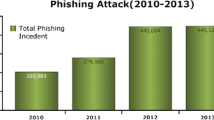Abstract
Intrusion detection need grows with the increase in the count and volume of Internet Traffic and Network. In this paper, intrusion detection system (IDS) is proposed to identify and distinguish the incoming traffic from the clients and traffic originating through the attackers by using the honeypot security mechanism. Load Balancer is designed and implemented in such a way that it differentiates between the incoming traffic from clients, and the traffic that arises through the attackers. When forwarding the request, it discovers if the traffic is an attack on the server and directs it to a different/alternate server called Honey-Pot. The IDS is developed and intensified with two protocols: File-based detection and Real-time based detection. The File based detection works on question model and the Real-time based detection sets priority levels for accessing data. This acts as a secure-direct protocol thereby increasing the Server protection. The Secure direct method prompts an immediate response to define network intrusions and eliminates human interference to identity the intrusions. Further an interaction with IDS is done to decide whether the traffic is a trespasser. If the traffic is found to be an access user the packet is transmitted to server, but if found to be an unauthorized user, then the IDS directly transmits it to the server.






Similar content being viewed by others
References
Misra, R., Renu, D.: Cyber crime investigation and network forensic system using honeypot. Int. J. Latest Trends Eng. Technol. 1, 34–40 (2012)
Li, Z.C., Li, X.J., Gong, L , Computer forensics system based on honeypot. In: Proceedings of the Third International Symposium on Computer Science and Computational Technology (ISCSCT’10), August, pp. 336–337 (2010)
Vasilomanolakis, E., Karuppayah, S., MÜhlhäuser, M., Fischer, M.: Taxonomy and survey of collaborative intrusion detection. ACM Comput. Surv. 47(4), 55 (2015)
Mairh, A., Barik, D., Verma, K., Jena, D.: Honeypot in network security: a survey. In: Proceedings of the International Conference on Communication, Computing & Security. ACM, 2011, pp. 600–605 (2011)
Bringer, M.L., Chelmecki, C.A., Fujinoki, H.: A survey: Recent advances and future trends in honeypot research. Int. J. 4, 63 (2012)
Spitzner, L.: The honeynet project: trapping the hackers. IEEE Secur. Priv. 1(2), 15–23 (2003). https://doi.org/10.1109/MSECP.2003.1193207
Vasilomanolakis, E., Karuppayah, S., Kikiras, P. MÜhlhäuser, M.: A honeypot-driven cyber incident monitor: lessons learned and steps ahead. In: Proceedings of the 8th International Conference on Security of Information and Networks. ACM, pp. 158–164 (2015)
Kaur, T., Malhotra, V., Singh, D.: Comparison of network security tools-Firewall, Intrusion detection system and Honeypot. int. J. Enhanc. Res. Sci. Technol. Eng. 3, 200–204 (2014)
Suo, X., Hue, X., Gao, Y.: Research on the application of honeypot technology in intrusion detection system. IEEE, vol. NA, pp. 1030–1032 (2014)
Koch, R., Golling, M., Dareo, G.: Attracting sophisticated attacks to secure systems: a new honeypot architecture. IEEE vol. NA, 409–410 (2013)
Rathore, P., Jain, N.: Honeypot technique used for intrusion detection system. Int. J. Sci. Eng. Technol. Res. (IJSETR) 2(12) (2013)
Mohammadzadeh.e.n, H., Honarbakhsh, R., Zakaria, O.: A survey on dynamic honeypots. Int. J. Inf. Electron. Eng. 2(2) (2012)
Somwanshi, A.A., Joshi, S.A.: Implementation of honeypots for server security. Int. Res. J. Eng. Technol. 03(03), 285–288 (2016)
Nawrocki, M., Wählisch, M., Schmidty, T.C., Keilz, C., Schonfelderz, J.: Survey on honeypot software and data analysis. All content following this page was uploaded by Christian Keil on 17 October (2016)
Mirza, M., Usman, M., Biuk-Aghai, R.P., Fong, S.: A modular approach for implementation of honeypots in cyber security. Int. J. Appl. Eng. Res. 11(8), 5446–5451 (2016)
Malav, S., Avinash, M.S., Satish, N.S., Sandeep, S.C.: Network security using IDS, IPS & honeypot. Int. J. Recent Res. Math. Comput. Sci. Inf. Technol. 2(2), 27–30 (2015–2016). www.paperpublications.org
Bijone, M.: A survey on secure network: intrusion detection & prevention approaches. Am. J. Inf. Syst. 4(3), 69–88 http://pubs.sciepub.com/ajis/4/3/2 ©Science and Education Publishing, https://doi.org/10.12691/ajis-4-3-2(2016)
Fowler, S., Zeadally, S., Chilamkurti, N.: Impact of denial of service solutions on network quality of service. Secur. Commun. Netw. 4(10), 1089–1103 (2011)
Author information
Authors and Affiliations
Corresponding author
Rights and permissions
About this article
Cite this article
Veena, K., Meena, K. Implementing file and real time based intrusion detections in secure direct method using advanced honeypot. Cluster Comput 22 (Suppl 6), 13361–13368 (2019). https://doi.org/10.1007/s10586-018-1912-x
Received:
Revised:
Accepted:
Published:
Issue Date:
DOI: https://doi.org/10.1007/s10586-018-1912-x




